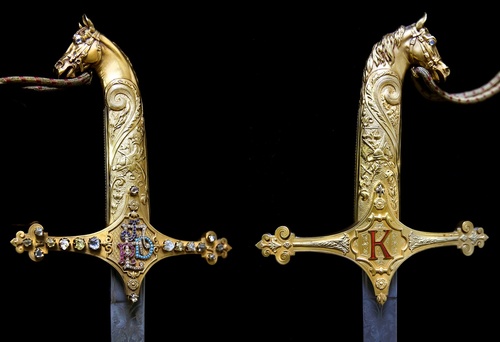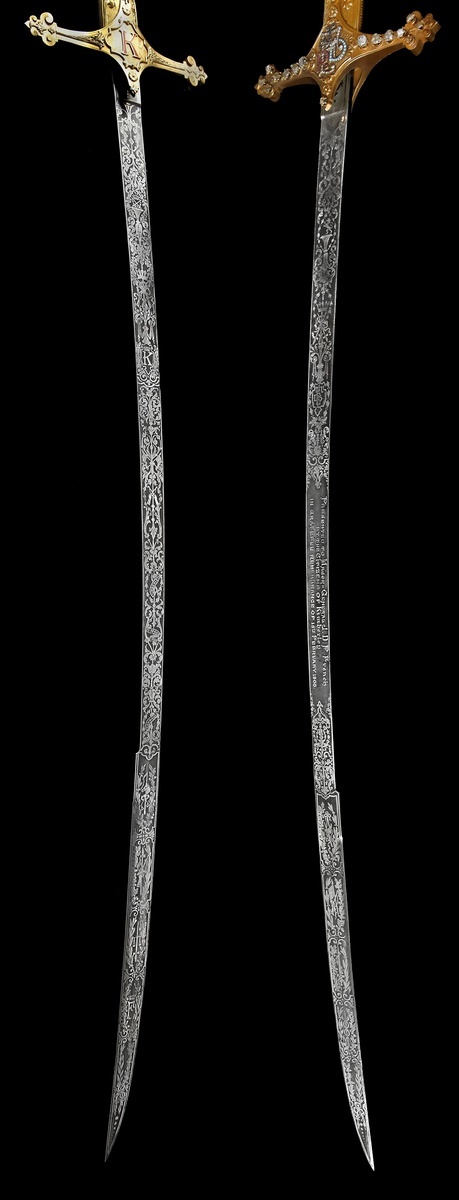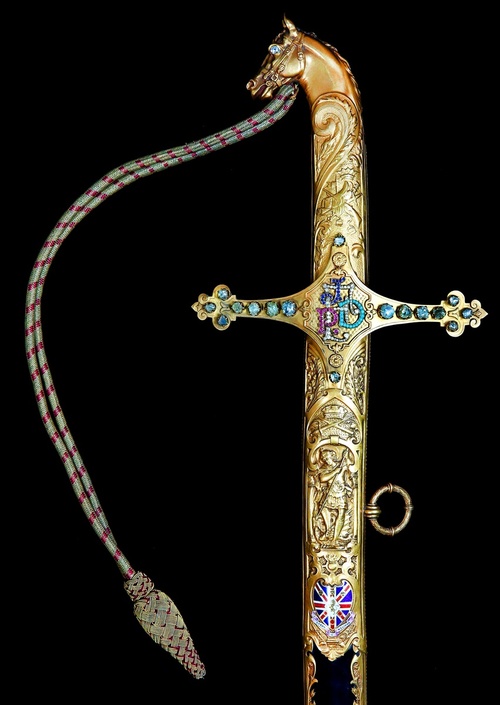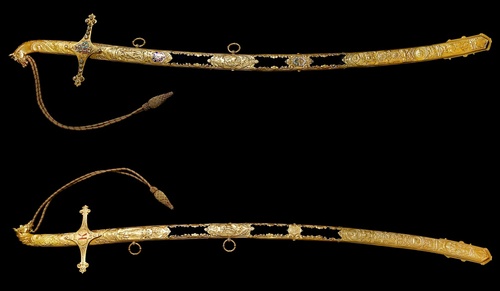Auction: 17003 - Orders, Decorations and Medals
Lot: 646
'… a very handsome and costly Sword of Honour…'
The magnificent gold-and-diamond-hilted sword presented by the Citizens of Kimberley to Major-General J. D. P. French in 1902
A sabre: overall length (across curve) 39¾ in. (101cm.); blade length (across curve) 32¾ in. (83cm.)
The hilt wholly of gold. The pommel in the form of a bridled horse's head in the round, the eyes comprising two rough, uncut Kimberley diamonds and the mane running partly down the backpiece. The grip formed of two parts, joined at front and back, each repoussé and decorated with arabesques and equestrian trophies of arms in polished metal on a matte ground and incorporating a Vallary crown and the scales of justice, the borders of the grip chased with a ribbon decoration (a small dent at the centre of the nearside). The quillons of reducing square section with langets and spatulate trefoil terminals; the offside set with sixteen rough, uncut Kimberley diamonds, the quillon block mounted with a cypher of the letters JDPF, the J in eighteen sapphires, the D in twenty-one turquoises, the P in nineteen rubies and the F in thirty-nine diamonds, all on a hatched ground enclosed by a raised border incorporating fleurs-de-lys and roses; the nearside mounted with acanthus leaves, the quillon block mounted with a letter K in yellow metal and scarlet enamel, all on a hatched ground enclosed by a raised border with fleurs-de-lys and roses above and below. Pendant from the hilt, through a yellow metal loop formed as part of the horse's bridle, a sword knot of crimson-and-gold round-cord with an acorn terminal.
The blade of flattened triangular section, double-edged for the last 10¼ in. (26cm.) and with a latched back 1½ in. (4cm.) long. Etched overall with foliate decoration and iconography, that on the offside incorporating a lion rampant, a Vallary crown above two swords in saltire, the cypher JDPF, trophies of arms, a single sword and the rod of Aesculapius, the iconography flanking the inscription
PRESENTED TO MAJOR-GENERAL J.D.P. French
BY THE CITIZENS OF Kimberley
IN GRATEFUL REMEMBRANCE OF 15TH FEBRUARY 1900
and that on the nearside incorporating crossed swords and crossed rifles beneath Vallary crowns, a letter K beneath a Vallary crown, crossed Union flags, crossed rifles, the words KIMBERLEY, S. AFRICA 1900 and SOUDAN, a horse's head, stirrups and a lance, a trophy of arms, the scales of justics and the letter F beneath a Vallary crown.
The scabbard of wood, covered in dark blue velvet and mounted in gold, the upper two mounts struck on the offside with the hallmarks for the London assaying year 1900-01, the standard mark for 18 carat gold and the maker's mark of the Goldsmiths' and Silversmiths' Company Ltd. and the other mounts gold. The scabbard mounts repoussé in polished and matte metal and coloured enamels with the following iconographic symbolism. Upper mount, offside: a sword and scabbard in saltire beneath a mural crown; St George, dismounted, killing the dragon; a flaming grenade; a slightly incorrect rendering of the Arms and Motto of the town of Kimberley (the correct blazon for which is: Azure, a cross and saltire superimposed Gules, both fimbriated Argent, in chief three bezants Or, each charged with a fleur-de-lis Azure and in base three annulets Or, on a lozenge Or, superimposed over the fess point a lion rampant Gules). Middle mount, offside: a seated figure of Britannia between two horses' heads; a trophy of arms and a rifle. Intermediate mount, offside: the Crest and Motto of J.D.P. French (a dolphin naiant Proper and MALO MORI QUAM FOEDARI). Bottom mount, offside: a demi-warrior with sword and targe; a flaming grenade; a trophy of arms above a shield bearing the letter F beneath a Vallary crown; the scales and sword of justice; two mounted cavalry soldiers, that at sinister armed with a lance. Upper mount, nearside: an Imperial Tudor crown above the rod of Aesculapius and an anchor in saltire; a standing figure of Britannia; a flaming grenade; a lion rampant. Middle mount, nearside: the figure of Victory with a shield bearing the inscription P.F./ SOUTH AFRICA/01. Intermediate mount, nearside: the letter K beneath a mural crown, all within a rectangle. Bottom mount, nearside: a demi-angel issuing from a Vallary crown, all flanked by scrolls bearing the inscriptions KIMBERLEY and 1900; a flaming grenade; an equestrian trophy of arms; a helmeted profile head of Minerva; acanthus leaves above and below a helmeted mask. The scabbard's throat-mount and shoe are in gilded yellow-metal alloy, as are its two suspension rings, which are engraved with a laurel-leaf pattern and embellished with three sets of triple-rings, themselves passing through triple-ring mounts attached to the top and middle scabbard mount.
Enclosed in its mahogany, silk-lined box 43¾ in. (111cm.) x 9 in. (23cm.) x 2½ in. (2.5cm.), the lid stamped in gold with the retailer's name and address: The Goldsmiths' and Silversmiths' Company Ltd, 112 Regent Street, London W., By Special Appointment to the Queen. The box lid now lacking its original escutcheon.
This magnificent sword, presented to Major-General (afterwards Field Marshal) J. D. P. French in Kimberley on 13 June 1902, was referred to in his diary entry for that day as 'a very handsome and costly sword of honour'. It commemorates the relief of the siege of Kimberley by a force commanded by French on 15 February 1900.
The sword exhibits marked similarities with one presented at the same time by the Mayor and Corporation of the City of Cape Town to Field Marshal Lord Roberts and now in the National Army Museum, London (accession number 1963-10-171). Both swords are of sabre form, with spatulate quillons and enamelled decoration; both are fashioned in 18 carat gold; both bear inscriptions remarkably similar in their script to each other and both were supplied by the Goldsmiths and Silversmiths' Company, London (fl. 1880-1952). Elements of the design - such as the standing figure of Britannia - are repeated on both swords: it is thus very likely that both swords were designed and produced simultaneously, probably being designed by the same person. French's sword is decorated overall with patriotic British iconography in the style of its period. Its conspicious decoration with rough, uncut Kimberley diamonds is reflective of the place of Kimberley as the centre of the South African diamond fields and the headquarters in South Africa of the firm De Beers. The noticeable and frequent use of 'Vallary' crowns in the sword's iconography reflects the symbolism of that device as one traditionally associated with, and awarded to, the successful leader of an attack on a fortress or other stronghold: this was of course appropriate to French as the leader of the force that so spectacularly relieved Kimberley.
John Denton Pinkstone French was born in Ripple Vale, near Deal, Kent, on 28 September 1852. After two years at the Royal Naval College, Dartmouth, he entered the Royal Navy as a midshipman in 1868. Resigning from the Navy in 1870, he was commissioned supernumerary Lieutenant in the Suffolk Artillery Militia in 1872, from which he was commissioned Lieutenant in 8th (or King's Royal Irish) Hussars in 1874, transferring in the same year to 19th (Princess of Wales's Own) Hussars. He remained with the 19th Hussars for the next nineteen years, being promoted Captain in 1880 and Major in 1883 and commanding the regiment in the rank of Lieutenant-Colonel from 1888 until 1893. He served with distinction in Wolseley's attempt to relieve the besieged General Gordon in Khartoum in 1884-85 and took the 19th Hussars to India in 1889. In the substantive rank of Colonel in 1895, French was appointed Assistant Adjutant-General at the War Office and was subsequently posted to command, first, the 2nd Cavalry Brigade at Canterbury in 1897 and, second, the 1st Cavalry Brigade at Aldershot in 1899.
On the outbreak of the South African War in 1899 French was appointed to command the cavalry in Natal in the temporary rank of Major-General but his command was subsequently extended to cover the Cavalry Division throughout the campaigning area and he was given the local rank of Lieutenant-General late in 1899. French's cavalry distinguished itself at the battle of Elandslaagte in October 1899 and he subsequently escaped from Ladysmith just before the Boers sealed the perimeter of the besieged town in November 1899. By early 1900, Ladysmith, Mafeking and Kimberley were all besieged, and being bombarded, by Boer forces and one of the initial tasks of the newly appointed Commander-in-Chief in South Africa, Field Marshal Lord Roberts, was to engineer the relief of those sieges. French took 4,000 cavalry across the Riet and Modder Rivers and, charging through thinly-held Boer positions at Klip Drift, his force relieved the siege of Kimberley on 15 February 1900. The remainder of the South African War saw French's cavalry in action at Poplar Grove later in 1900 and at the captures of Middelburg in July and Barberton in September 1900. As the war became more 'guerrilla' in nature, French commanded in the Johannesburg district in November 1900 and in Cape Colony from June 1901. He was promoted substantive Major-General in 1900 and appointed a Knight Commander of the Order of the Bath (K.C.B.) in recognition of his services in the early part of the war. On his return home, in August 1902, he was promoted Lieutenant-General and appointed a Knight Commander of the Order of St. Michael and St. George (K.C.M.G.).
The South African War had brought French into the public spotlight as one of the more successful commanders of the war and his subsequent career reflected this. Appointed to command at Aldershot in September 1902 and joining the Committee of Imperial Defence in December 1905, French was promoted General in February 1907 and appointed a Knight Grand Cross of the Royal Victorian Order (G.C.V.O.). In November 1907 he was appointed Inspector-General of the Forces and held the appointment of A.D.C. to The King 1911-13. Having achieved a reputation as a dynamic moderniser, French was appointed Chief of the Imperial General Staff in March 1912 and promoted Field Marshal in June 1913. He was the natural choice to command the British Expeditionary Force in France and Flanders on the outbreak of the First World War in August 1914.
French remained in command of the B.E.F. - which had grown into two Army Groups by December 1914 - until December 1915, by which time confidence in his handling of the British part of the war had diminished. On his return home, he was appointed Commander-in-Chief, Home Forces, and created Viscount French of Ypres. His handling of home defence proved generally sound and he held an unofficial position as strategic adviser to the Prime Minister, Lloyd George, before being appointed Lord Lieutenant of Ireland in May 1918, a position that he retained until April 1921, after which he was created Earl of Ypres. His last appointment was as Constable of Deal Castle in August 1923 and he died there in May 1925.
French's career has undergone historical analysis from the time of his death until the present day, the current informed opinion being that, a product of the 19th century 'cavalry school' of warfare, he was temperamentally and intellectually unsuited to the challenges of mass 20th century warfare. He was, though, not among the 'butcher and bungler' Generals so much caricatured from the 1930s to the 1960s and has been less chastised in death than has Haig, with whom he served for many years in a variety of roles. His extensive collection of Orders of Chivalry and decorations are in the collections of the Imperial War Museum, as are most of his papers.
Reference sources:
Culme, J., The Directory of Gold & Silversmiths, Jewellers and Allied Traders from the London Assay Office Registers 1938-1914 (Woodbridge, 1987), Vol. I, pp. 183-185.
Holmes, E.R., The Little Field Marshal: Sir John French (London, 1981), p. 118 and passim.
Imperial War Museum: Documents 7813; papers of Field Marshal Sir John French, 1st Earl of Ypres; French's diary for the period 1900-1902/03.
Subject to 20% VAT on Buyer’s Premium. For more information please view Terms and Conditions for Buyers.
Sold for
£30,000











